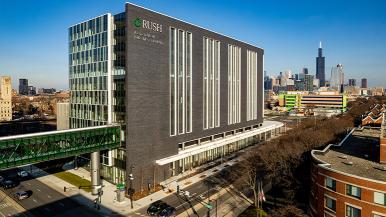Every little bit counts when it comes to sustainability. And for RUSH’s Joan and Paul Rubschlager Building, it was a priority.
For example, more than 30% of the products in the new building — a destination for cancer, neuroscience and digestive disease care — includes recycled materials, and 46% were manufactured and harvested within 500 miles of RUSH.
Those are just a couple of reasons that led to the building becoming LEED-gold certified. It is now the third building on the RUSH University Medical Center campus to be LEED-certified.
“The is an important milestone in helping RUSH achieve our overall sustainability and decarbonization goals,” says Alyssa Zymali, senior project manager at Jacobs, who helped manage the construction and sustainability efforts in the new building. “This certification would not have been possible without the collaborative team of designers, engineers, project managers and construction trade workers.”
More about sustainability
The Joan and Paul Rubschlager Building also features a new lighting system to minimize electricity use. It works with occupancy sensors and window shades to optimize daylight, turn off lights in unoccupied rooms and adjust brightness throughout the day.
Other examples of sustainability in the new building include the following:
- During construction, 94% of debris was diverted from the landfill, and more than 3,000 tons of construction waste was recycled.
- Over 86% of furniture purchased so far meet the Healthier Hospital Interior criteria for eliminating chemicals of concern.
- A comprehensive recycling plan was developed for the building's occupants.
- The building’s design reduced greenhouse gas emissions by 1,088 metric tons of CO2 equivalent. This savings is equal to the electricity needed to power 38 homes for a year, or 4.4 tanker trucks full of gasoline.
Here’s what you can do to help
Sustainability efforts in the new building “help to shrink our environmental footprint, and minimize our impact on local, regional and global communities, directly improving the health of people living within them,” says Ian Hughes, sustainability manager at RUSH.
And we can all do our part to promote sustainability in our daily lives, no matter the size.
“Small actions like turning off lights when not in the room or powering off devices when not in use can make a big collective impact,” says Katie Pittman, sustainability coordinator at RUSH. “Don’t be fooled by the idea that small actions don’t matter.”
To learn more about the Joan and Paul Rubschlager Building, visit rush.edu/rubschlager.




